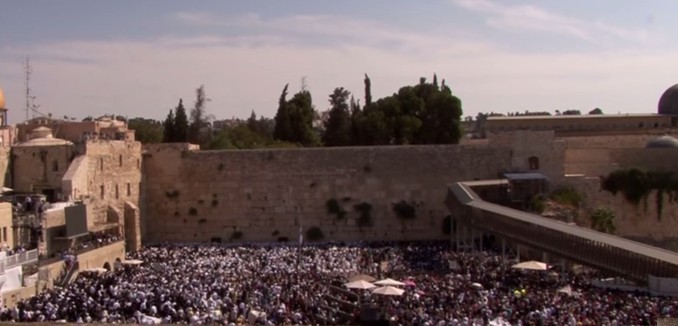Dr. Michael Satlow, a professor of religious studies and Judaic studies at Brown University, wrote today that the existence of a Jewish temple on the Temple Mount is “as historically certain a fact as one can get.” Satlow’s statement, published on his website, was prompted by a report yesterday in The New York Times suggesting that the temple’s historical existence was a matter of controversy.
Satlow argued that the Times article conflated three distinct questions, but that once these were addressed separately, there remained “very little disagreement among professional historians about most of them.”
Did a Jewish temple stand on the present day Temple Mount? Yes. This is as historically certain a fact as one can get in the study of ancient history. The Temple Mount was built by Herod beginning at the end of the first century BCE – the Western Wall is the western retaining wall of that reshaping of the natural hill – and on top of it were a number of structures that belonged to the Jewish temple. These included courtyards, altars, and the Holy of Holies. Now it is true (and has long been recognized even in Jewish law) that we do not know precisely where on the Temple Mount those structures stood, but there is no question that they stood there.
Prior to Herod’s renovation of the temple, did it stand at this site? Almost certainly. I would give it a 98% possibility. The second temple was built around 520 BCE and underwent a few renovations before Herod gave it a major overhaul. If Herod moved the site of the temple we would know, both from the extensive archaeological excavations conducted all around the temple as well from literary sources. People notice stuff like that.
Was the second temple built on the same site as the first? Here there is scholarly uncertainty. The first temple was destroyed in 586 BCE along with the entire city of Jerusalem. When Jews returned from Babylonia to rebuild the temple, were they careful to find the site of the old structure, clear the rubble, and build it on the same exact spot? It seems likely, but this we really don’t know. The question is further complicated by the biblical record, in which God never tells Solomon precisely where in Jerusalem he is to build a temple. It is possible that the precise spot did not matter very much to the Israelites at this time. If the first temple did not stand within the confines of the present Temple Mount, though, it would have been within a couple of hundred meters.
Satlow then argued that “by distorting history in order to promote specific claims,” the Times story damaged peace efforts.
Attempts to undermine Jewish claims to the Temple Mount, which the Times noted have led many Palestinians to “increasingly [express] doubt that the temples ever existed,” is a phenomenon that Dr. Dore Gold, former Israeli Ambassador to the United Nations and Director-General of the Israel Ministry of Foreign Affairs, described as “Temple denial.” David Hazony, editor of The Tower, wrote in 2007 that “Palestinian leaders, writers, and scholars have embarked on a campaign of intellectual erasure […] aimed at undermining the Jewish claim to any part of the land.”
In 1999, while expanding the al-Aqsa mosque, the Jerusalem Islamic Waqf – the religious authority in charge of governing the Temple Mount – dug and removed roughly 400 truckloads of topsoil from the complex, which they dumped in a landfill at Jerusalem’s Kidron Valley under the cover of night. Israeli archaeologists, who were able to retrieve most but not all of the soil, consequently began to sift it in an effort to recover some ancient artifacts. Among the relics found are thousands of coins from the Second Temple period and the imprint of an ancient Jewish seal.
In 2007, the Waqf used a tractor to dig a 4-foot-deep trench on the northern end of the Temple Mount, allegedly to replace old electric cables. At the time, archaeologist Zachi Zweig said, “there is a high probability that ancient remnants were damaged,” among them the foundation of a wall that could have belonged to the Second Temple. That incident led to the formation of the Israeli Committee for the Prevention of Destruction of Antiquities on the Temple Mount, which aims to prevent further damage to ancient artifacts by ongoing renovations at the site.
This past February, police arrested two Waqf employees who refused to end unauthorized construction on the complex, as well as a Jewish man who was praying there illegally. All non-Muslim religious activity on the Temple Mount is forbidden.
[Photo: Online videos from Israel, Middle East & Jewish World / YouTube ]




